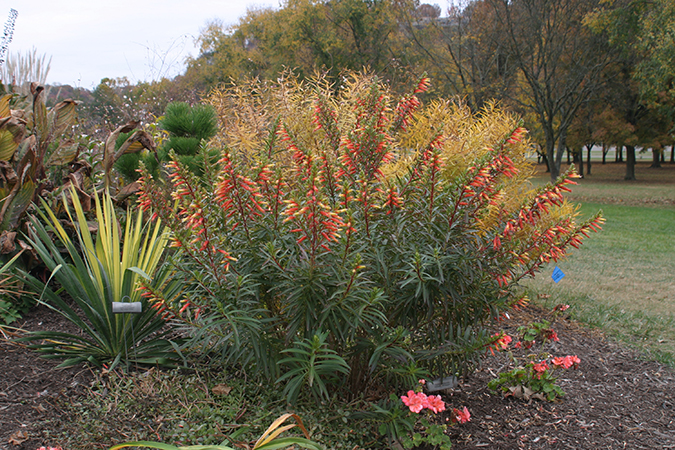| |
12:14 p.m. October 8, 2015
UT Gardens October 2015 Plant of the Month: Candy Corn Plant
By James Newburn
Assistant Director, University of Tennessee Gardens, Knoxville

A "half-hardy" Candy Corn Plant with its bright orange and yellow blooms, lived through six winters at the UT Gardens, Knoxville. Image by J. Newburn, courtesy UTIA. |
By now many of us are enjoying shorter days and cooler temperatures. As we head into fall, our thoughts turn to football, freshly baked apple pies, and Halloween. Halloween turns our thoughts to candy and that most classic of Halloween candies: candy corn. At least it does for me, which has inspired this month’s UT Gardens Plant of the Month. The Candy Corn Plant, or Cuphea micropetala, does indeed have a flower that resembles the iconic candy or as some see it a lit cigar. That gives rise to another of common name of the plant, Mexican Giant Cigar Plant. Whatever similarity you see, this plant is a great addition to the garden.
There are hundreds of cuphea species and several are grown and sold as annual bedding plants in Tennessee. These include bat-faced cupheas and a popular hybrid called ‘Vermillion’. Cuphea micropetela, however, I would classify as a half-hardy perennial. This Mexican native is one of the hardier species and several catalogs suggest that it is hardy to zone 7B. Plant Delights Nursery states that they have had reliable results as a perennial to 8 degrees. In the UT Gardens Knoxville, we had one plant overwinter for at least six years until last winter’s extended colder temperatures finally did it in. They’ve also experienced good overwintering success at the UT Gardens, Jackson.
The appeal of this plant is the wonderful tubular blooms that appear along sturdy stalks on the 3’ x 3’ herbaceous shrub. The one-half to one-inch flowers begin to appear in late summer and bloom until a killing frost. Starting out pale yellow, the flowers soon darken as they age to a wonderful red-orange that compliments the fall foliage color palette and reminds one of the aforementioned candy corn or lit cigar. While the temperatures are still warm, hummingbirds are very attracted to the flowers. It serves also as an attractant to butterflies and bees.
Cuphea micropetala requires full sun and good drainage for maximum flower production and plant health. New plants survive best when planted in the spring and allowed to establish themselves all season. Once established, this plant can tolerate dry conditions. As an herbaceous plant, it will die completely to the ground after a hard freeze. An extra layer of mulch at that time may provide additional protection from winter cold. Clean up the dead foliage in early spring and look for new stems to emerge in late spring. The plant looks great in a rock garden, in a mixed perennial border or as a specimen plant.
Ask your local garden center if they plan on having this wonderful fall bloomer. If not, you can find it in catalogs or online with a little searching. The reward for your efforts will be a beautiful addition to your late-summer and fall landscape.
James Newburn is Assistant Director of the University of Tennessee Gardens, Knoxville. The UT Gardens located in Knoxville, Crossville and Jackson are part of the UT Institute of Agriculture and have been designated as the official botanical garden for the State of Tennessee. The gardens are open during all seasons and free to the public except during designated special events. For more information see utgardens.tennessee.edu.
Published October 8, 2015
|

